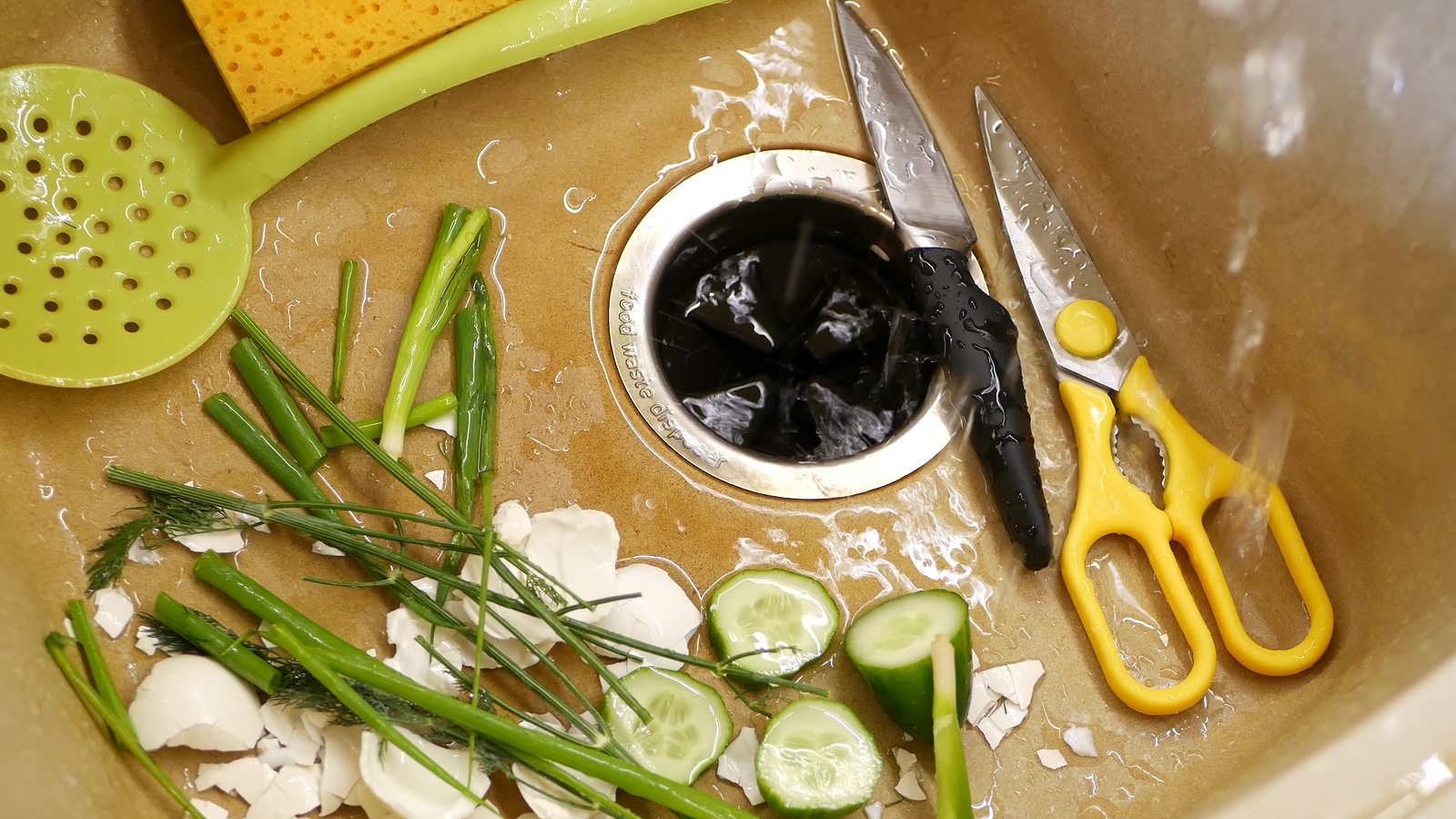The garbage disposal is the workhorse of the kitchen. Yet, it’s a device that we assume will always be at our ‘disposal’ at the flip of a switch.
Sadly, that isn’t always the case. I think most of us have, at one time or another, flipped that switch and heard the dreaded humming sound.
How a garbage disposal works
Before diving into the troubleshooting and fixing process, it’s important to understand the basic functionality of a garbage disposal.
These units are installed under your kitchen sink and are designed to shred food waste into small particles that can safely pass through your plumbing. Here’s a simplified breakdown of how they work:
- When you turn on the disposal by flipping a switch, it activates an electric motor.
- The motor rotates a grinding chamber containing impellers or blades. These blades shred and break down food waste into smaller pieces.
- Water from your faucet is used to wash the shredded particles down the drain, ensuring they are carried away through the plumbing.
- The ground-up food waste is carried away to the sewage system or septic tank, depending on your home’s setup.

What causes a jammed garbage disposal?
Several factors can lead to a jammed garbage disposal:
- Foreign Objects: The most common cause of jams is foreign objects, such as utensils, small bones, or non-food items, accidentally falling into the disposal.
- Overloading: Putting too much food waste into the disposal at once can overwhelm it and lead to jamming.
- Improper Use: Running the disposal without enough water or not letting it run long enough after grinding can cause clogs. Not understanding what can and cannot be put into the disposal is also a common cause of jams.
- Dull Blades: Over time, the blades in your disposal can become dull, making it less effective at grinding food waste.
Safety considerations before working on the disposal
Before attempting to fix a stuck garbage disposal, ensure your safety.
Turn off the Power: Always disconnect the power to the disposal to prevent accidental starts. Locate the circuit breaker or power switch for the disposal and turn it off.
Cut the Power Cord: If your disposal doesn’t have a dedicated switch or breaker, you may want to unplug it. If it’s hardwired, consult an electrician.
Use Protective Gear: Wear gloves and eye protection to safeguard against any potential debris or sharp objects.
Never Reach In: Avoid putting your hand into the disposal, even when it’s disconnected. Instead, use tools for retrieval.
![]()
Tools needed to get the job done
To fix a jammed garbage disposal, you’ll need a few essential tools:
Hex Wrench (Allen Wrench): Most disposals come with a hex wrench for manually turning the disposal’s flywheel to free obstructions. If you’ve misplaced yours, use a ¼-inch Allen wrench.
Needle Nose Pliers: Long-nose pliers are useful for extracting objects that may be causing the jam. You can also use kitchen tongs.
Bucket: To catch any water or debris that may lead while working on the disposal.
Flashlight: This helps you see inside the disposal for a better view of the problem.
Let’s get to it: Fixing a a stuck garbage disposal
Follow these steps to troubleshoot and fix a jammed garbage disposal:
Turn Off the Power: Ensure the disposal is completely disconnected from the power source.
Inspect the Jam: Use a flashlight to look inside the disposal and identify the cause of the jam. If you see any foreign objects, carefully use tongs or kitchen pliers to remove them.
Use the Hex Wrench: There is an area on the bottom of the disposal where you can insert the hex wrench. Yes, you will need to lay down under the sink to see it. Manually turn the flywheel back and forth to free any obstructions. This may require some effort, so be patient.
Reset the Disposal: After clearing the jam, press the reset button, typically located on the bottom or side of the disposal. This will reset the safety mechanism.
Turn the Power Back On: Reconnect the power and test the disposal with a small amount of food waste. Ensure it’s running smoothly before using it for larger loads.

Avoiding future jams and keeping your disposal clean
Preventing future jams and maintaining a clean garbage disposal is crucial for its longevity and efficiency. Here’s how to do it:
Always use cold water when using the disposal: “Hot water may cause fats to congeal. When congealed, fats and oils can stick to the blades of your disposal and cause the system to work harder than necessary, impacting the motor,” cautions the pros with Smith & Keene.
Snake the drain: Smith & Keene pros also suggest snaking the drain every two years. Snakes are inexpensive at the big home improvement stores.
Be mindful of what you put in the disposal: Avoid putting hard or fibrous items like bones, fruit pits, potato and apple peels, and corn husks into the disposal. Avoid pouring grease down the drain and never throw rice, pasta or bread into the unit.
Regular Cleaning: Clean your disposal every two weeks to prevent odors and buildup. Pour ice cubes into the disposal and run it with cold water for a few seconds. This helps clean the blades and dislodges debris.
Use a degreaser: Occasionally use a degreaser to help keep down the amount of fat that can build up and cause even more problems.
Getting rid of what’s jamming a garbage disposer is a super easy DIY project. Remember to follow the safety precautions and use the right tools and your disposal should run like a champ!


